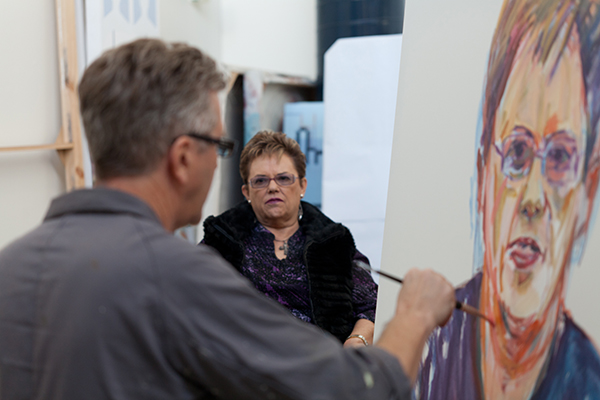Avondale lecturer studies his subjects for PhD in portraiture
An artist who spends more time with the subject of a painted portrait reveals more about the subject’s character, doctoral research by an Avondale lecturer shows.
Dr Andy Collis examined the value of the artist–sitter relationship to contemporary portrait painting for his PhD thesis, The human touch? A physical meeting between the two “is of significant value to the expression of the artist’s ideas, the practice of painting, and as a unique testimonial of [the] relationship for that period of time,” he writes.
Portrait painting is a unique platform, he adds, because its creation “is necessarily dependant on the cooperation and collaboration of both parties, often artist and non-artist; two divergent worlds coming together in which, nevertheless, an artwork relies.”
A portrait session with Paralympian Liesl Tesch during which she commented to Collis about the incorrect positioning of her arms is an example of Collis’s theory in practice. “My fellow sailors . . . thought I was flying a kite,” said Tesch at the time. Collis repainted Tesch’s arms, which not only gave the portrait more authenticity but also improved its artistic quality by adding dimension and movement.
A portrait of Lindy Chamberlain-Creighton, the subject of one of Australia’s most publicised legal cases, forms part of Collis’s thesis. Chamberlain-Creighton was wrongly convicted in 1982 of the murder of her baby daughter, Azaria, who was taken by a dingo at the then Ayers Rock in 1980. Collis wanted to paint a portrait that went beyond Chamberlain-Creighton’s media portrayal, one that captured her emotions and memories. He felt he could do this only by spending time with Chamberlain-Creighton rather than by simply using second-hand imagery. It is this connection between the artist and sitter that gives portraits more “intimacy and authenticity,” says Collis.
Collis’s research taught him the importance of challenging old ideas to learn new practices. For example, he experimented with different paint mediums and with the idea of presence by painting on a large 1.8- by 2.4-metre scale—“the sheer physicality of the portraits hits you,” he says. Collis will use these discoveries to develop his skills as an artist and to reinvigorate his teaching.
Judges selected Collis’s portraits of daughter Annie-Rose and Chamberlain-Creighton as semi-finalists for the Doug Moran Portrait Prize, the world’s richest at $150,000, in 2012 and 2013. The portrait of Annie-Rose and two self-portraits are former finalists for the Gosford Regional Prize, while others have hung in the Gosford Regional Gallery and The University of Newcastle Art Gallery. Collis is currently exhibiting for the KAB Gallery in Terrigal, where he is one of its stable of artists.
While conferred, Collis, a senior lecturer in visual communication, will receive his testamur from The University of Newcastle later this year.
View Collis’s work at the KAB Gallery or by visiting andycollis.tumblr.com.
Share

